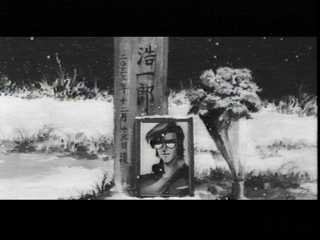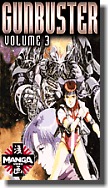![]()


Episode 6: At the End of the Endless Stream
Copyright: GAINAX (Japan), US Renditions (North America)
Length: 50 minutes
Rating: NR, parental guidance suggested
Format: Subtitled (VHS)
Directed by: Hideaki Anno Produced by: English translation: Yoshida Toshifume, Trish Ledoux
![]()

At long last, the human race is ready to put an end to the terrible war that has come at such a terrible price. Lt. Colonel Ohta Kazumi, now widowed, prepares to leave behind the job once held by her mentor and husband, in order to complete one last mission: the delivery of Buster Machine No. 3, the Black Hole Bomb. Years have passed since Coach Ohta's desperate gambit saved the Earth -- the resulting shockwaves destroyed the enemy fleet, consumed three planets and devasted the Earth's surface. All of the Earth's resources have been directed towards a single goal: to detonate the Black Hole Bomb deep in the core of the enemy's own galaxy, and rid the Earth of creatures that have been so intent on wiping out mankind. Can their plan succeed? Will Earth finally see peace? Does mankind have the right to unleash weapons of such destructive power?
![]()
|
This is my favourite of the GunBuster episodes -- and for good reason, too. Perhaps the single biggest reason is the manner in which the episode is presented: in black and white. Gainax was reportedly in financial trouble during production of this series, but I don't believe that the decision to present the final episode in black and white was due to economics. Instead, I think that this was done deliberately, for artistic effect. The final battle scene, done in sketchy drawings and roughs better conveyed the tremendous fight better than most fully-realized animations I've seen, by invoking your imagination. Once again, the details in the series really shines -- the relationship between Noriko, Kazumi and their friends, the advancement of technology throughout the series, and especially the use of time dilation. Story direction is incredible, with several scenes that cause me to get goosebumps -- in particular, a scene when Noriko and Kazumi are escaping the blast from the Black Hole Bomb, and Noriko cries out, "Gomen, Kimiko! Mo aierenai!" ("I'm sorry, Kimiko -- I won't be able to see you again!"), which then immediately cuts to a scene with Kimiko and her daughter, dressed in yukatas, hanging prayers for Noriko on a tree. Kimiko looks up, believing that she had heard Noriko's voice. That, and the very final scene, when they finally return home after 12,000 years, and the scene switches from black and white to colour. A wonderfully very deft touch, which I'm sure was inspired by The Wizard of Oz. The end theme is one of the most beautifully orchestrated pieces of music I've ever heard in animé or otherwise (check out the MIDI file.) GAINAX truly deserves the title of "the most innovative animation company in the world." - AN The final episode and it's done *very* differently from the rest of the episodes. The animation quality is in parts still well done albeit in black and white, while the final battle itself is done in stills and production sketches. Can we say that Gainax was pretty much broke at this point? Still, when it comes down to it, it's a very effective way of doing the final episode and the feel of the episode comes across as being that much more grave. The minimal use of colour gives the movie a touch of despair that would be difficult to impart with colour. The music in the final episode is fantastic, especially the final theme song. While I don't care much for the Hallelujah chorus (well hey! It's not as fun as other pieces for a choir to perform -- it's downright boring actually) it's a very fitting piece for a last ditch effort in the hopes of a miracle. The show touched very briefly on the ethics of destroying a galaxy for human kind's continued survival although it didn't really go into it. Even so, it does make you wonder just to what extent we have the right to destroy others and each other. It's an ethical question which the show left alone and rightly so; it has no real place in a story of survival and would have made for a major side trip in the plot line. That plus it simply doesn't fit into the overall story line. Still, it does make you wonder how er... history would judge these actions when Amano and Noriko returned to earth some 12000 years later. A solid ending for this OAV series, and one that's guaranteed to leave you with a tear in your eye. - JYN |
![]()
| Original: | Subbed: | Dubbed: | |
|---|---|---|---|
| Story: | N/A | N/A | |
| Direction: | N/A | N/A | |
| Acting: | N/A | N/A | |
| Animation: | N/A | N/A | |
| Music: | N/A | N/A | |
| Translation: | N/A | N/A | |
| Overall Rating: | N/A | N/A |
![]()
[ << prev ] [ top ] [ next >> ]
[ home ]
[ what's new ]
[ café contest ]
[ café reviews ]
[ parent's guide ]
[ encyclopædia ]
[ café trivia ]
[ café latté ]
[ café espresso ]
[ about the café ]
[ feedback ]
[ links ]
[ site map ]
© 1997-2000. All rights reserved. The Animé Café logo and the Crystal Kyoko award are original creations of the Animé Café. Please do not use any of the materials on this site without the expressed written permission of the Animé Café.
Page last modified 2000.02.27
